Analyzing Ethical Dilemmas in DNR Orders: A Comprehensive Study
VerifiedAdded on 2023/06/12
|12
|3381
|313
Essay
AI Summary
This essay delves into the ethical and legal considerations surrounding Do Not Resuscitate (DNR) orders, examining the principles of autonomy, beneficence, non-maleficence, and justice as they apply to medical decision-making. It discusses the role of physicians in consulting with patients and their families to make informed decisions about resuscitation, particularly in cases of terminal illness where DNR orders can reduce suffering. The essay also explores the legal framework surrounding euthanasia and DNR orders, referencing the Australian context and the Rights of Terminally Ill Act. Ultimately, it emphasizes the importance of balancing patient autonomy with ethical responsibilities to ensure compassionate and fair end-of-life care. Desklib provides access to similar essays and study resources for students.
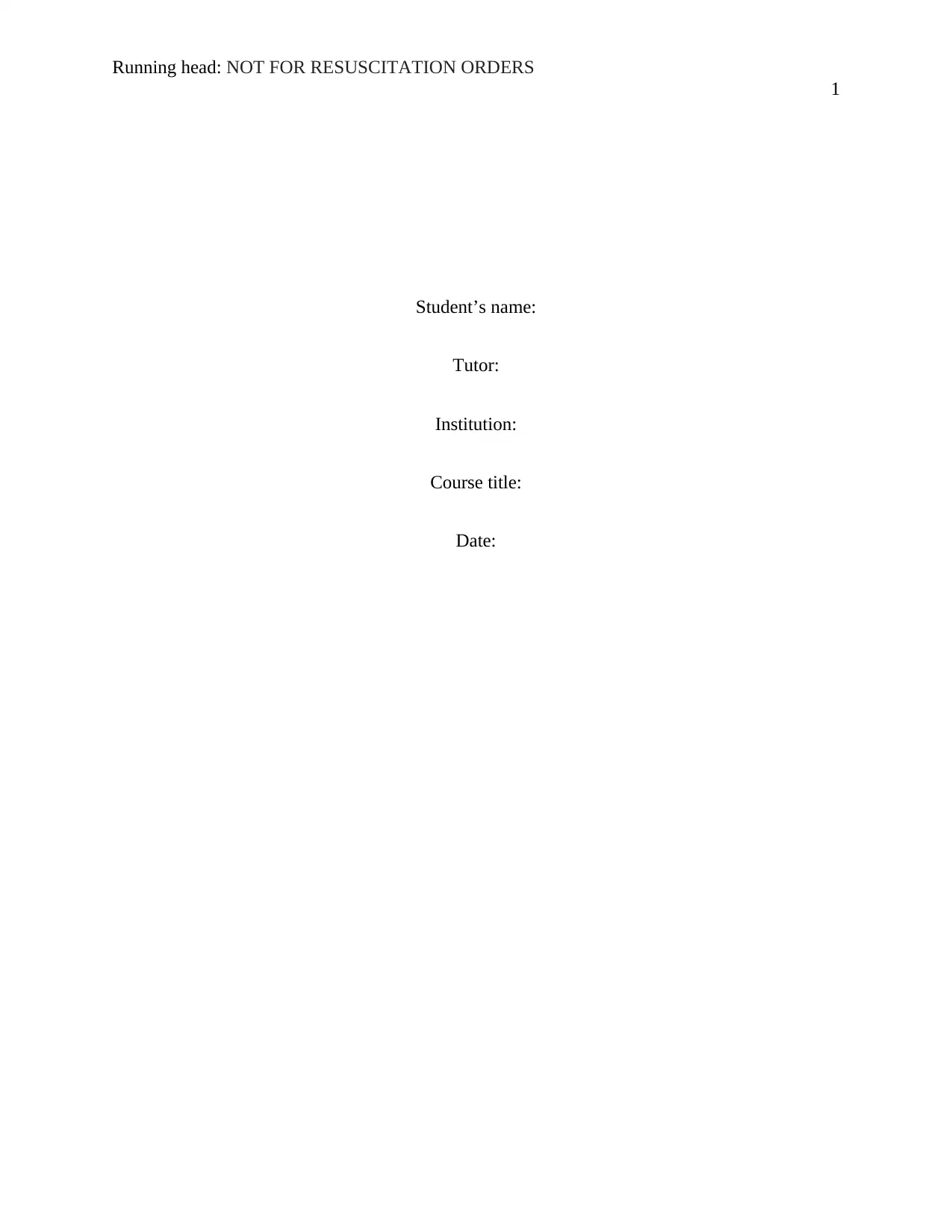
Running head: NOT FOR RESUSCITATION ORDERS
1
Student’s name:
Tutor:
Institution:
Course title:
Date:
1
Student’s name:
Tutor:
Institution:
Course title:
Date:
Paraphrase This Document
Need a fresh take? Get an instant paraphrase of this document with our AI Paraphraser
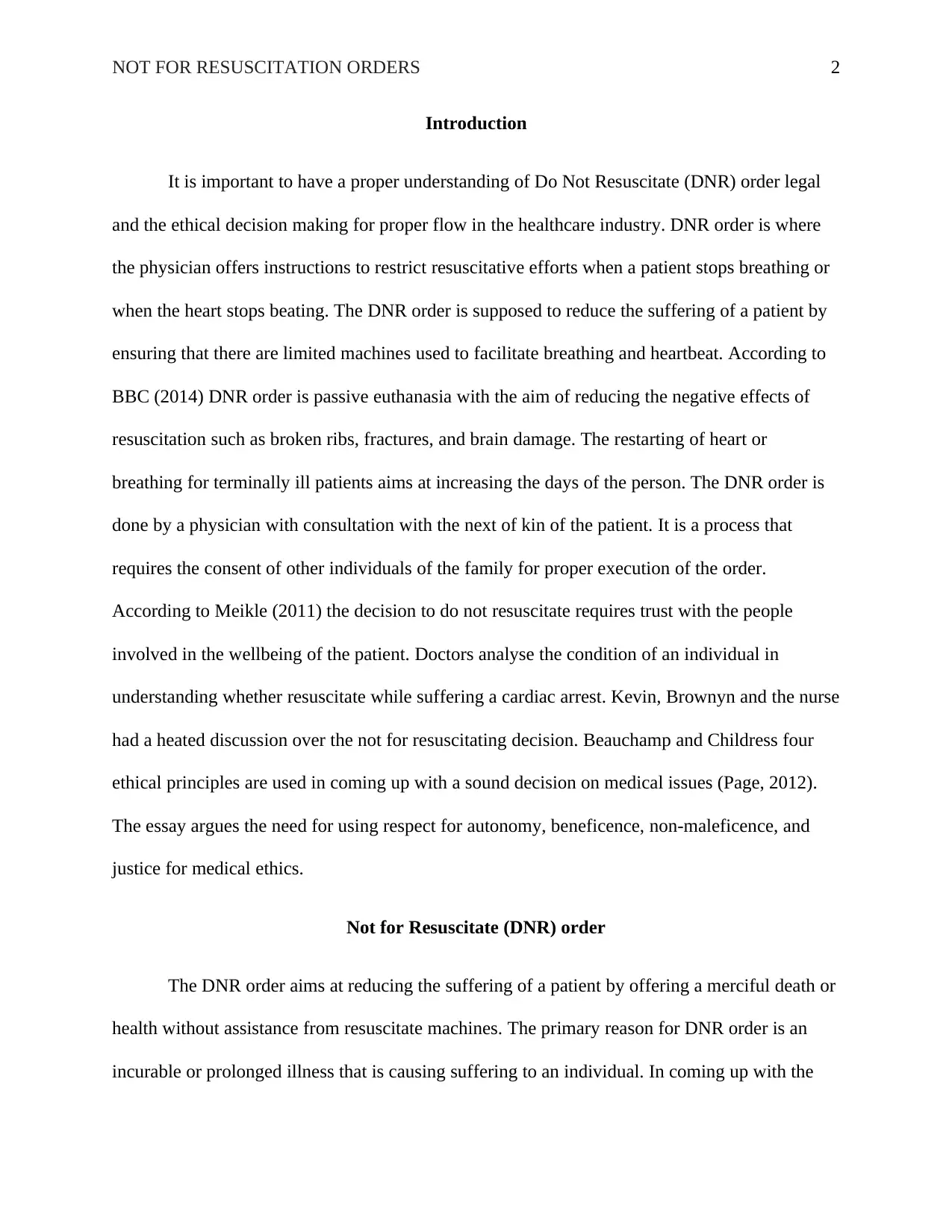
NOT FOR RESUSCITATION ORDERS 2
Introduction
It is important to have a proper understanding of Do Not Resuscitate (DNR) order legal
and the ethical decision making for proper flow in the healthcare industry. DNR order is where
the physician offers instructions to restrict resuscitative efforts when a patient stops breathing or
when the heart stops beating. The DNR order is supposed to reduce the suffering of a patient by
ensuring that there are limited machines used to facilitate breathing and heartbeat. According to
BBC (2014) DNR order is passive euthanasia with the aim of reducing the negative effects of
resuscitation such as broken ribs, fractures, and brain damage. The restarting of heart or
breathing for terminally ill patients aims at increasing the days of the person. The DNR order is
done by a physician with consultation with the next of kin of the patient. It is a process that
requires the consent of other individuals of the family for proper execution of the order.
According to Meikle (2011) the decision to do not resuscitate requires trust with the people
involved in the wellbeing of the patient. Doctors analyse the condition of an individual in
understanding whether resuscitate while suffering a cardiac arrest. Kevin, Brownyn and the nurse
had a heated discussion over the not for resuscitating decision. Beauchamp and Childress four
ethical principles are used in coming up with a sound decision on medical issues (Page, 2012).
The essay argues the need for using respect for autonomy, beneficence, non-maleficence, and
justice for medical ethics.
Not for Resuscitate (DNR) order
The DNR order aims at reducing the suffering of a patient by offering a merciful death or
health without assistance from resuscitate machines. The primary reason for DNR order is an
incurable or prolonged illness that is causing suffering to an individual. In coming up with the
Introduction
It is important to have a proper understanding of Do Not Resuscitate (DNR) order legal
and the ethical decision making for proper flow in the healthcare industry. DNR order is where
the physician offers instructions to restrict resuscitative efforts when a patient stops breathing or
when the heart stops beating. The DNR order is supposed to reduce the suffering of a patient by
ensuring that there are limited machines used to facilitate breathing and heartbeat. According to
BBC (2014) DNR order is passive euthanasia with the aim of reducing the negative effects of
resuscitation such as broken ribs, fractures, and brain damage. The restarting of heart or
breathing for terminally ill patients aims at increasing the days of the person. The DNR order is
done by a physician with consultation with the next of kin of the patient. It is a process that
requires the consent of other individuals of the family for proper execution of the order.
According to Meikle (2011) the decision to do not resuscitate requires trust with the people
involved in the wellbeing of the patient. Doctors analyse the condition of an individual in
understanding whether resuscitate while suffering a cardiac arrest. Kevin, Brownyn and the nurse
had a heated discussion over the not for resuscitating decision. Beauchamp and Childress four
ethical principles are used in coming up with a sound decision on medical issues (Page, 2012).
The essay argues the need for using respect for autonomy, beneficence, non-maleficence, and
justice for medical ethics.
Not for Resuscitate (DNR) order
The DNR order aims at reducing the suffering of a patient by offering a merciful death or
health without assistance from resuscitate machines. The primary reason for DNR order is an
incurable or prolonged illness that is causing suffering to an individual. In coming up with the
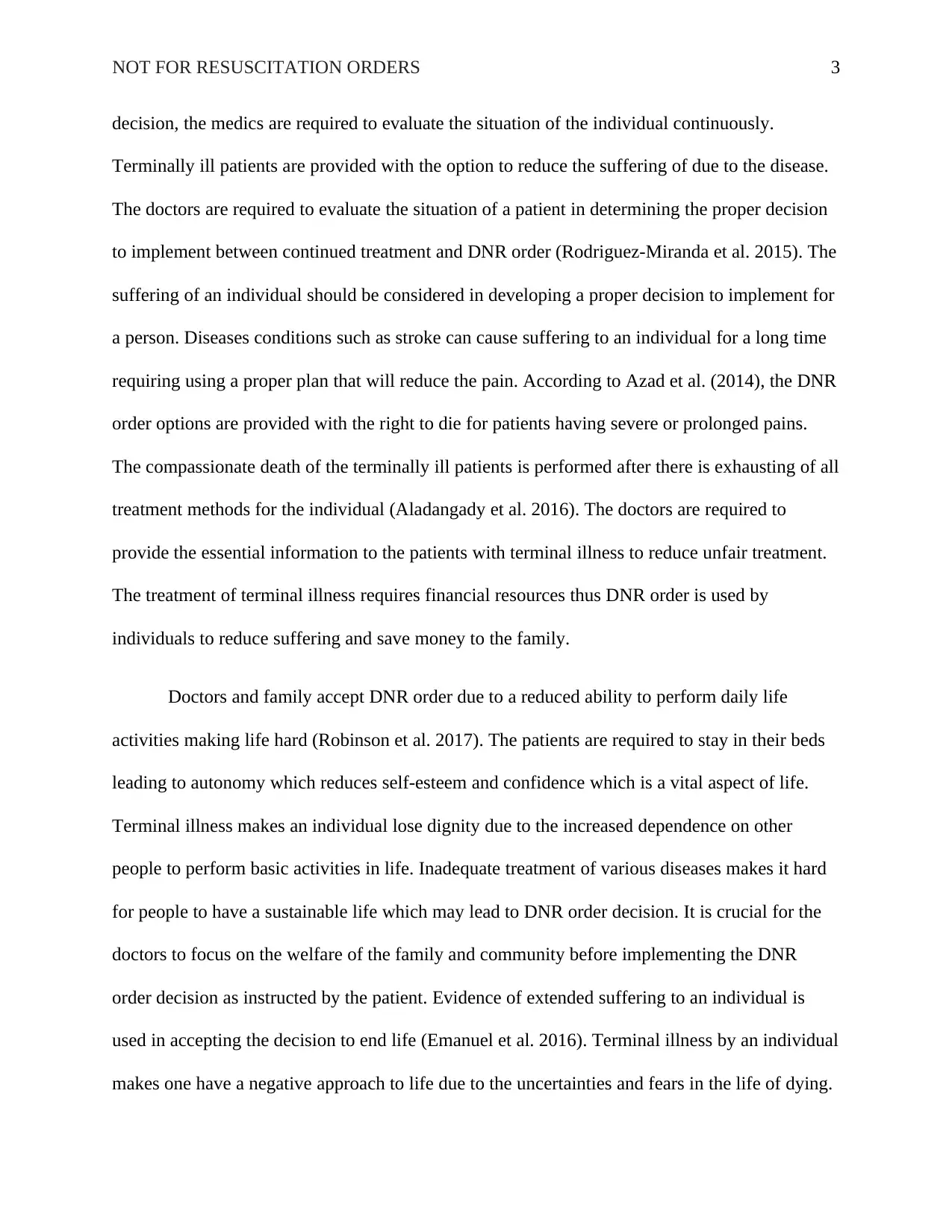
NOT FOR RESUSCITATION ORDERS 3
decision, the medics are required to evaluate the situation of the individual continuously.
Terminally ill patients are provided with the option to reduce the suffering of due to the disease.
The doctors are required to evaluate the situation of a patient in determining the proper decision
to implement between continued treatment and DNR order (Rodriguez-Miranda et al. 2015). The
suffering of an individual should be considered in developing a proper decision to implement for
a person. Diseases conditions such as stroke can cause suffering to an individual for a long time
requiring using a proper plan that will reduce the pain. According to Azad et al. (2014), the DNR
order options are provided with the right to die for patients having severe or prolonged pains.
The compassionate death of the terminally ill patients is performed after there is exhausting of all
treatment methods for the individual (Aladangady et al. 2016). The doctors are required to
provide the essential information to the patients with terminal illness to reduce unfair treatment.
The treatment of terminal illness requires financial resources thus DNR order is used by
individuals to reduce suffering and save money to the family.
Doctors and family accept DNR order due to a reduced ability to perform daily life
activities making life hard (Robinson et al. 2017). The patients are required to stay in their beds
leading to autonomy which reduces self-esteem and confidence which is a vital aspect of life.
Terminal illness makes an individual lose dignity due to the increased dependence on other
people to perform basic activities in life. Inadequate treatment of various diseases makes it hard
for people to have a sustainable life which may lead to DNR order decision. It is crucial for the
doctors to focus on the welfare of the family and community before implementing the DNR
order decision as instructed by the patient. Evidence of extended suffering to an individual is
used in accepting the decision to end life (Emanuel et al. 2016). Terminal illness by an individual
makes one have a negative approach to life due to the uncertainties and fears in the life of dying.
decision, the medics are required to evaluate the situation of the individual continuously.
Terminally ill patients are provided with the option to reduce the suffering of due to the disease.
The doctors are required to evaluate the situation of a patient in determining the proper decision
to implement between continued treatment and DNR order (Rodriguez-Miranda et al. 2015). The
suffering of an individual should be considered in developing a proper decision to implement for
a person. Diseases conditions such as stroke can cause suffering to an individual for a long time
requiring using a proper plan that will reduce the pain. According to Azad et al. (2014), the DNR
order options are provided with the right to die for patients having severe or prolonged pains.
The compassionate death of the terminally ill patients is performed after there is exhausting of all
treatment methods for the individual (Aladangady et al. 2016). The doctors are required to
provide the essential information to the patients with terminal illness to reduce unfair treatment.
The treatment of terminal illness requires financial resources thus DNR order is used by
individuals to reduce suffering and save money to the family.
Doctors and family accept DNR order due to a reduced ability to perform daily life
activities making life hard (Robinson et al. 2017). The patients are required to stay in their beds
leading to autonomy which reduces self-esteem and confidence which is a vital aspect of life.
Terminal illness makes an individual lose dignity due to the increased dependence on other
people to perform basic activities in life. Inadequate treatment of various diseases makes it hard
for people to have a sustainable life which may lead to DNR order decision. It is crucial for the
doctors to focus on the welfare of the family and community before implementing the DNR
order decision as instructed by the patient. Evidence of extended suffering to an individual is
used in accepting the decision to end life (Emanuel et al. 2016). Terminal illness by an individual
makes one have a negative approach to life due to the uncertainties and fears in the life of dying.
⊘ This is a preview!⊘
Do you want full access?
Subscribe today to unlock all pages.

Trusted by 1+ million students worldwide
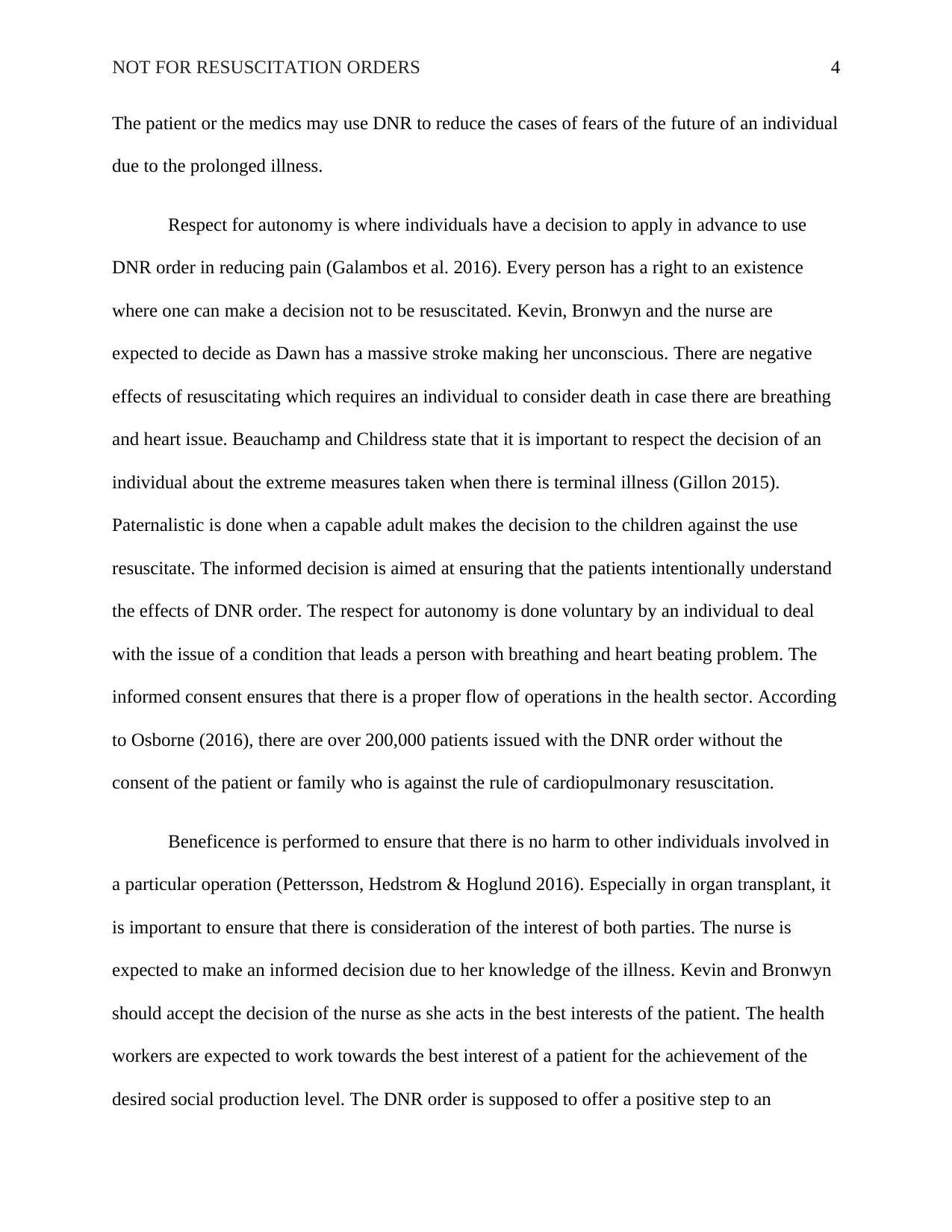
NOT FOR RESUSCITATION ORDERS 4
The patient or the medics may use DNR to reduce the cases of fears of the future of an individual
due to the prolonged illness.
Respect for autonomy is where individuals have a decision to apply in advance to use
DNR order in reducing pain (Galambos et al. 2016). Every person has a right to an existence
where one can make a decision not to be resuscitated. Kevin, Bronwyn and the nurse are
expected to decide as Dawn has a massive stroke making her unconscious. There are negative
effects of resuscitating which requires an individual to consider death in case there are breathing
and heart issue. Beauchamp and Childress state that it is important to respect the decision of an
individual about the extreme measures taken when there is terminal illness (Gillon 2015).
Paternalistic is done when a capable adult makes the decision to the children against the use
resuscitate. The informed decision is aimed at ensuring that the patients intentionally understand
the effects of DNR order. The respect for autonomy is done voluntary by an individual to deal
with the issue of a condition that leads a person with breathing and heart beating problem. The
informed consent ensures that there is a proper flow of operations in the health sector. According
to Osborne (2016), there are over 200,000 patients issued with the DNR order without the
consent of the patient or family who is against the rule of cardiopulmonary resuscitation.
Beneficence is performed to ensure that there is no harm to other individuals involved in
a particular operation (Pettersson, Hedstrom & Hoglund 2016). Especially in organ transplant, it
is important to ensure that there is consideration of the interest of both parties. The nurse is
expected to make an informed decision due to her knowledge of the illness. Kevin and Bronwyn
should accept the decision of the nurse as she acts in the best interests of the patient. The health
workers are expected to work towards the best interest of a patient for the achievement of the
desired social production level. The DNR order is supposed to offer a positive step to an
The patient or the medics may use DNR to reduce the cases of fears of the future of an individual
due to the prolonged illness.
Respect for autonomy is where individuals have a decision to apply in advance to use
DNR order in reducing pain (Galambos et al. 2016). Every person has a right to an existence
where one can make a decision not to be resuscitated. Kevin, Bronwyn and the nurse are
expected to decide as Dawn has a massive stroke making her unconscious. There are negative
effects of resuscitating which requires an individual to consider death in case there are breathing
and heart issue. Beauchamp and Childress state that it is important to respect the decision of an
individual about the extreme measures taken when there is terminal illness (Gillon 2015).
Paternalistic is done when a capable adult makes the decision to the children against the use
resuscitate. The informed decision is aimed at ensuring that the patients intentionally understand
the effects of DNR order. The respect for autonomy is done voluntary by an individual to deal
with the issue of a condition that leads a person with breathing and heart beating problem. The
informed consent ensures that there is a proper flow of operations in the health sector. According
to Osborne (2016), there are over 200,000 patients issued with the DNR order without the
consent of the patient or family who is against the rule of cardiopulmonary resuscitation.
Beneficence is performed to ensure that there is no harm to other individuals involved in
a particular operation (Pettersson, Hedstrom & Hoglund 2016). Especially in organ transplant, it
is important to ensure that there is consideration of the interest of both parties. The nurse is
expected to make an informed decision due to her knowledge of the illness. Kevin and Bronwyn
should accept the decision of the nurse as she acts in the best interests of the patient. The health
workers are expected to work towards the best interest of a patient for the achievement of the
desired social production level. The DNR order is supposed to offer a positive step to an
Paraphrase This Document
Need a fresh take? Get an instant paraphrase of this document with our AI Paraphraser
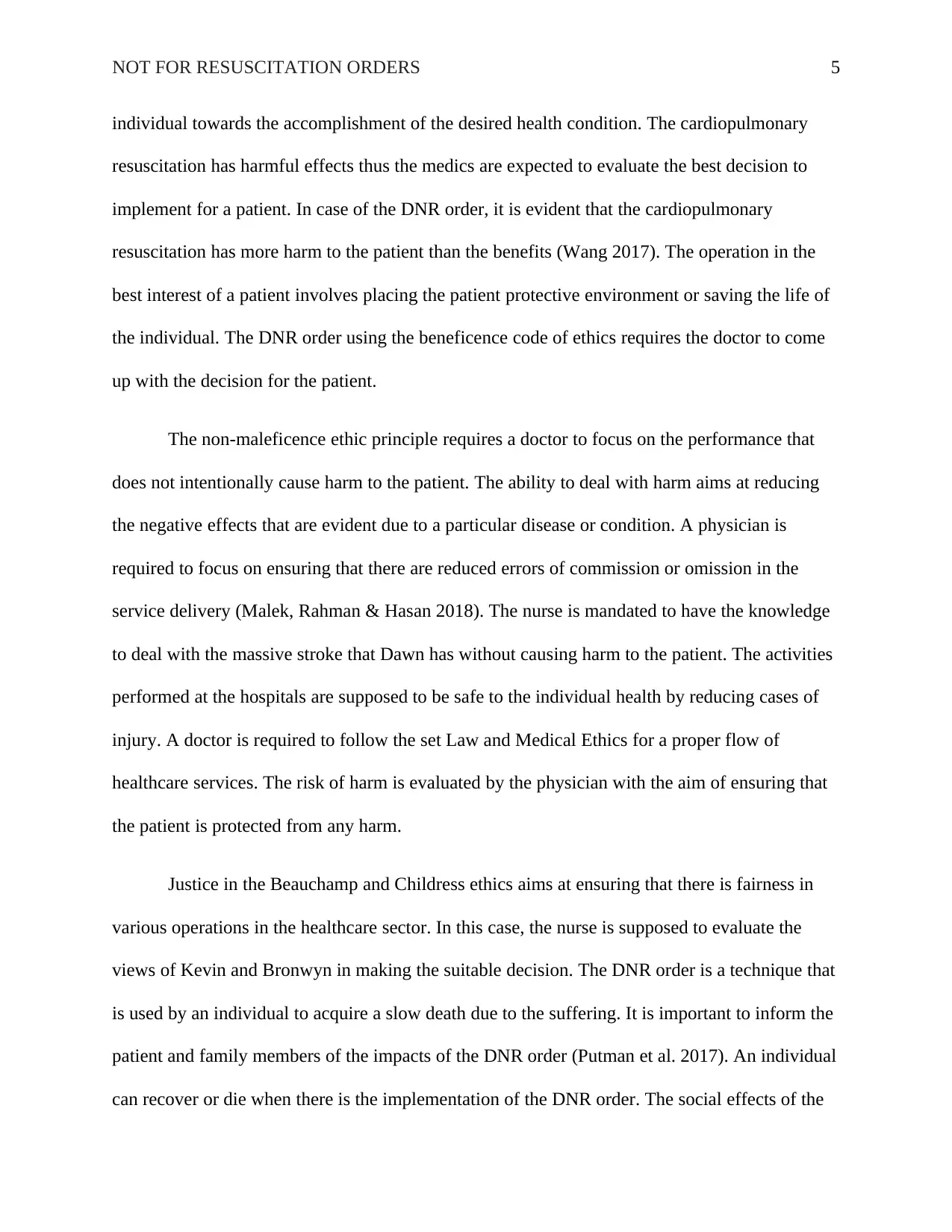
NOT FOR RESUSCITATION ORDERS 5
individual towards the accomplishment of the desired health condition. The cardiopulmonary
resuscitation has harmful effects thus the medics are expected to evaluate the best decision to
implement for a patient. In case of the DNR order, it is evident that the cardiopulmonary
resuscitation has more harm to the patient than the benefits (Wang 2017). The operation in the
best interest of a patient involves placing the patient protective environment or saving the life of
the individual. The DNR order using the beneficence code of ethics requires the doctor to come
up with the decision for the patient.
The non-maleficence ethic principle requires a doctor to focus on the performance that
does not intentionally cause harm to the patient. The ability to deal with harm aims at reducing
the negative effects that are evident due to a particular disease or condition. A physician is
required to focus on ensuring that there are reduced errors of commission or omission in the
service delivery (Malek, Rahman & Hasan 2018). The nurse is mandated to have the knowledge
to deal with the massive stroke that Dawn has without causing harm to the patient. The activities
performed at the hospitals are supposed to be safe to the individual health by reducing cases of
injury. A doctor is required to follow the set Law and Medical Ethics for a proper flow of
healthcare services. The risk of harm is evaluated by the physician with the aim of ensuring that
the patient is protected from any harm.
Justice in the Beauchamp and Childress ethics aims at ensuring that there is fairness in
various operations in the healthcare sector. In this case, the nurse is supposed to evaluate the
views of Kevin and Bronwyn in making the suitable decision. The DNR order is a technique that
is used by an individual to acquire a slow death due to the suffering. It is important to inform the
patient and family members of the impacts of the DNR order (Putman et al. 2017). An individual
can recover or die when there is the implementation of the DNR order. The social effects of the
individual towards the accomplishment of the desired health condition. The cardiopulmonary
resuscitation has harmful effects thus the medics are expected to evaluate the best decision to
implement for a patient. In case of the DNR order, it is evident that the cardiopulmonary
resuscitation has more harm to the patient than the benefits (Wang 2017). The operation in the
best interest of a patient involves placing the patient protective environment or saving the life of
the individual. The DNR order using the beneficence code of ethics requires the doctor to come
up with the decision for the patient.
The non-maleficence ethic principle requires a doctor to focus on the performance that
does not intentionally cause harm to the patient. The ability to deal with harm aims at reducing
the negative effects that are evident due to a particular disease or condition. A physician is
required to focus on ensuring that there are reduced errors of commission or omission in the
service delivery (Malek, Rahman & Hasan 2018). The nurse is mandated to have the knowledge
to deal with the massive stroke that Dawn has without causing harm to the patient. The activities
performed at the hospitals are supposed to be safe to the individual health by reducing cases of
injury. A doctor is required to follow the set Law and Medical Ethics for a proper flow of
healthcare services. The risk of harm is evaluated by the physician with the aim of ensuring that
the patient is protected from any harm.
Justice in the Beauchamp and Childress ethics aims at ensuring that there is fairness in
various operations in the healthcare sector. In this case, the nurse is supposed to evaluate the
views of Kevin and Bronwyn in making the suitable decision. The DNR order is a technique that
is used by an individual to acquire a slow death due to the suffering. It is important to inform the
patient and family members of the impacts of the DNR order (Putman et al. 2017). An individual
can recover or die when there is the implementation of the DNR order. The social effects of the
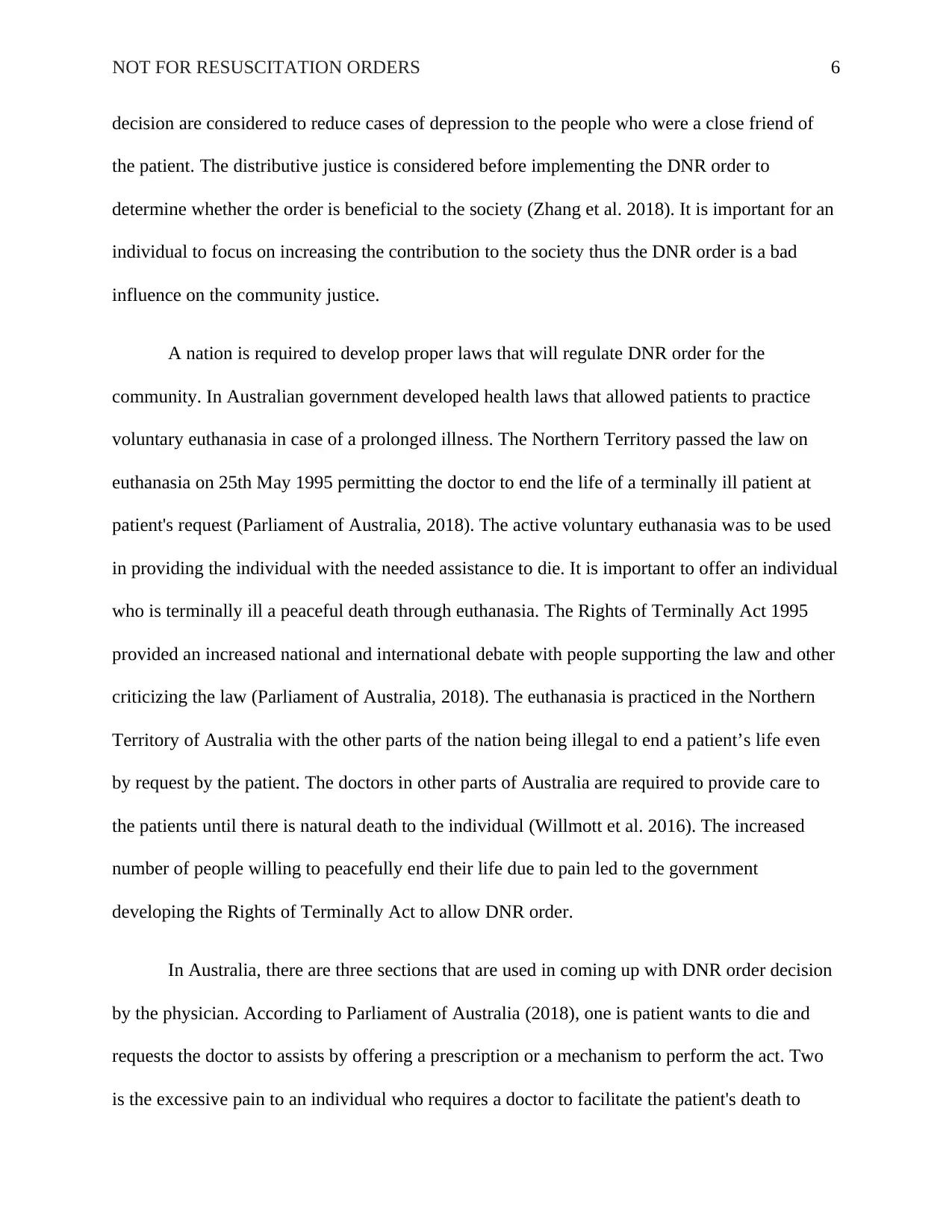
NOT FOR RESUSCITATION ORDERS 6
decision are considered to reduce cases of depression to the people who were a close friend of
the patient. The distributive justice is considered before implementing the DNR order to
determine whether the order is beneficial to the society (Zhang et al. 2018). It is important for an
individual to focus on increasing the contribution to the society thus the DNR order is a bad
influence on the community justice.
A nation is required to develop proper laws that will regulate DNR order for the
community. In Australian government developed health laws that allowed patients to practice
voluntary euthanasia in case of a prolonged illness. The Northern Territory passed the law on
euthanasia on 25th May 1995 permitting the doctor to end the life of a terminally ill patient at
patient's request (Parliament of Australia, 2018). The active voluntary euthanasia was to be used
in providing the individual with the needed assistance to die. It is important to offer an individual
who is terminally ill a peaceful death through euthanasia. The Rights of Terminally Act 1995
provided an increased national and international debate with people supporting the law and other
criticizing the law (Parliament of Australia, 2018). The euthanasia is practiced in the Northern
Territory of Australia with the other parts of the nation being illegal to end a patient’s life even
by request by the patient. The doctors in other parts of Australia are required to provide care to
the patients until there is natural death to the individual (Willmott et al. 2016). The increased
number of people willing to peacefully end their life due to pain led to the government
developing the Rights of Terminally Act to allow DNR order.
In Australia, there are three sections that are used in coming up with DNR order decision
by the physician. According to Parliament of Australia (2018), one is patient wants to die and
requests the doctor to assists by offering a prescription or a mechanism to perform the act. Two
is the excessive pain to an individual who requires a doctor to facilitate the patient's death to
decision are considered to reduce cases of depression to the people who were a close friend of
the patient. The distributive justice is considered before implementing the DNR order to
determine whether the order is beneficial to the society (Zhang et al. 2018). It is important for an
individual to focus on increasing the contribution to the society thus the DNR order is a bad
influence on the community justice.
A nation is required to develop proper laws that will regulate DNR order for the
community. In Australian government developed health laws that allowed patients to practice
voluntary euthanasia in case of a prolonged illness. The Northern Territory passed the law on
euthanasia on 25th May 1995 permitting the doctor to end the life of a terminally ill patient at
patient's request (Parliament of Australia, 2018). The active voluntary euthanasia was to be used
in providing the individual with the needed assistance to die. It is important to offer an individual
who is terminally ill a peaceful death through euthanasia. The Rights of Terminally Act 1995
provided an increased national and international debate with people supporting the law and other
criticizing the law (Parliament of Australia, 2018). The euthanasia is practiced in the Northern
Territory of Australia with the other parts of the nation being illegal to end a patient’s life even
by request by the patient. The doctors in other parts of Australia are required to provide care to
the patients until there is natural death to the individual (Willmott et al. 2016). The increased
number of people willing to peacefully end their life due to pain led to the government
developing the Rights of Terminally Act to allow DNR order.
In Australia, there are three sections that are used in coming up with DNR order decision
by the physician. According to Parliament of Australia (2018), one is patient wants to die and
requests the doctor to assists by offering a prescription or a mechanism to perform the act. Two
is the excessive pain to an individual who requires a doctor to facilitate the patient's death to
⊘ This is a preview!⊘
Do you want full access?
Subscribe today to unlock all pages.

Trusted by 1+ million students worldwide
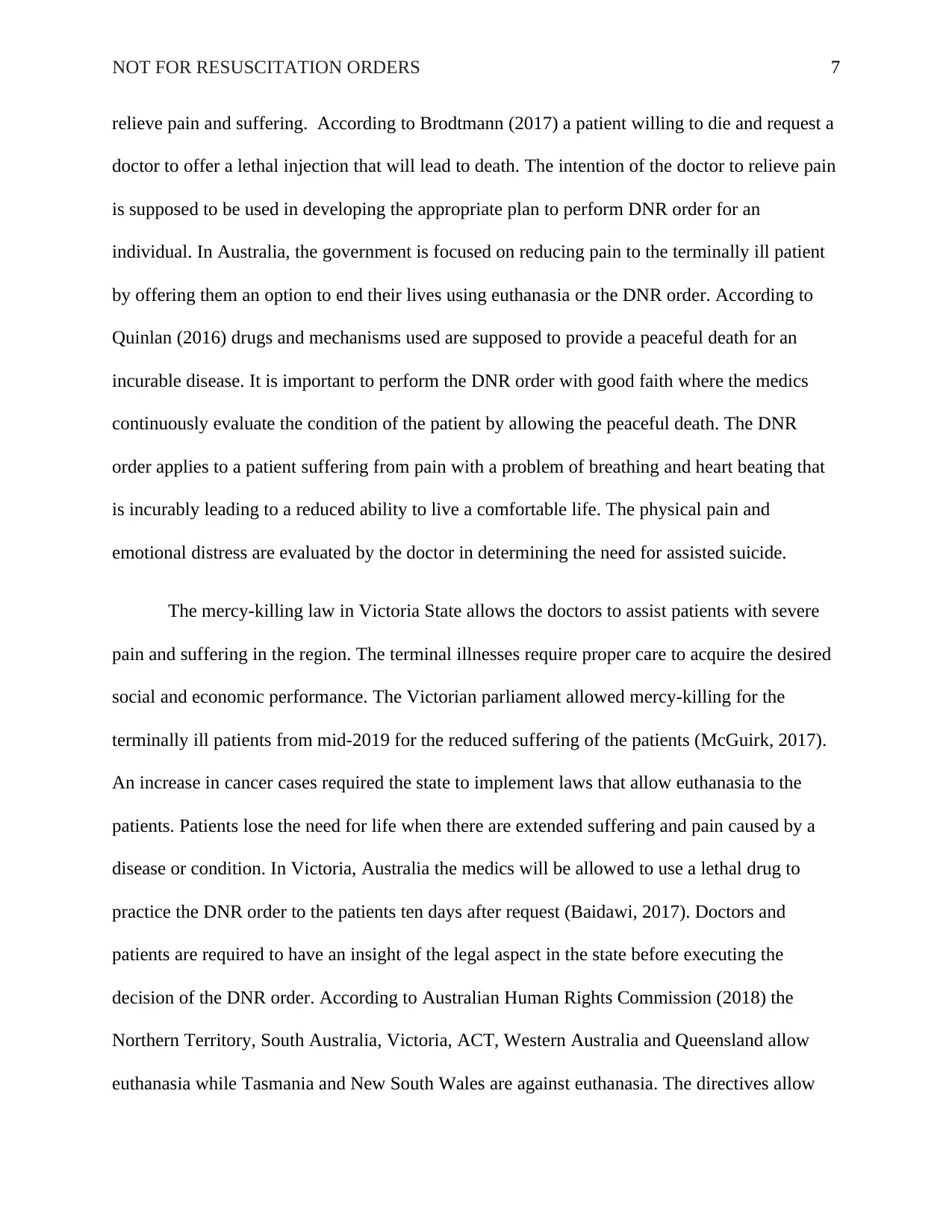
NOT FOR RESUSCITATION ORDERS 7
relieve pain and suffering. According to Brodtmann (2017) a patient willing to die and request a
doctor to offer a lethal injection that will lead to death. The intention of the doctor to relieve pain
is supposed to be used in developing the appropriate plan to perform DNR order for an
individual. In Australia, the government is focused on reducing pain to the terminally ill patient
by offering them an option to end their lives using euthanasia or the DNR order. According to
Quinlan (2016) drugs and mechanisms used are supposed to provide a peaceful death for an
incurable disease. It is important to perform the DNR order with good faith where the medics
continuously evaluate the condition of the patient by allowing the peaceful death. The DNR
order applies to a patient suffering from pain with a problem of breathing and heart beating that
is incurably leading to a reduced ability to live a comfortable life. The physical pain and
emotional distress are evaluated by the doctor in determining the need for assisted suicide.
The mercy-killing law in Victoria State allows the doctors to assist patients with severe
pain and suffering in the region. The terminal illnesses require proper care to acquire the desired
social and economic performance. The Victorian parliament allowed mercy-killing for the
terminally ill patients from mid-2019 for the reduced suffering of the patients (McGuirk, 2017).
An increase in cancer cases required the state to implement laws that allow euthanasia to the
patients. Patients lose the need for life when there are extended suffering and pain caused by a
disease or condition. In Victoria, Australia the medics will be allowed to use a lethal drug to
practice the DNR order to the patients ten days after request (Baidawi, 2017). Doctors and
patients are required to have an insight of the legal aspect in the state before executing the
decision of the DNR order. According to Australian Human Rights Commission (2018) the
Northern Territory, South Australia, Victoria, ACT, Western Australia and Queensland allow
euthanasia while Tasmania and New South Wales are against euthanasia. The directives allow
relieve pain and suffering. According to Brodtmann (2017) a patient willing to die and request a
doctor to offer a lethal injection that will lead to death. The intention of the doctor to relieve pain
is supposed to be used in developing the appropriate plan to perform DNR order for an
individual. In Australia, the government is focused on reducing pain to the terminally ill patient
by offering them an option to end their lives using euthanasia or the DNR order. According to
Quinlan (2016) drugs and mechanisms used are supposed to provide a peaceful death for an
incurable disease. It is important to perform the DNR order with good faith where the medics
continuously evaluate the condition of the patient by allowing the peaceful death. The DNR
order applies to a patient suffering from pain with a problem of breathing and heart beating that
is incurably leading to a reduced ability to live a comfortable life. The physical pain and
emotional distress are evaluated by the doctor in determining the need for assisted suicide.
The mercy-killing law in Victoria State allows the doctors to assist patients with severe
pain and suffering in the region. The terminal illnesses require proper care to acquire the desired
social and economic performance. The Victorian parliament allowed mercy-killing for the
terminally ill patients from mid-2019 for the reduced suffering of the patients (McGuirk, 2017).
An increase in cancer cases required the state to implement laws that allow euthanasia to the
patients. Patients lose the need for life when there are extended suffering and pain caused by a
disease or condition. In Victoria, Australia the medics will be allowed to use a lethal drug to
practice the DNR order to the patients ten days after request (Baidawi, 2017). Doctors and
patients are required to have an insight of the legal aspect in the state before executing the
decision of the DNR order. According to Australian Human Rights Commission (2018) the
Northern Territory, South Australia, Victoria, ACT, Western Australia and Queensland allow
euthanasia while Tasmania and New South Wales are against euthanasia. The directives allow
Paraphrase This Document
Need a fresh take? Get an instant paraphrase of this document with our AI Paraphraser
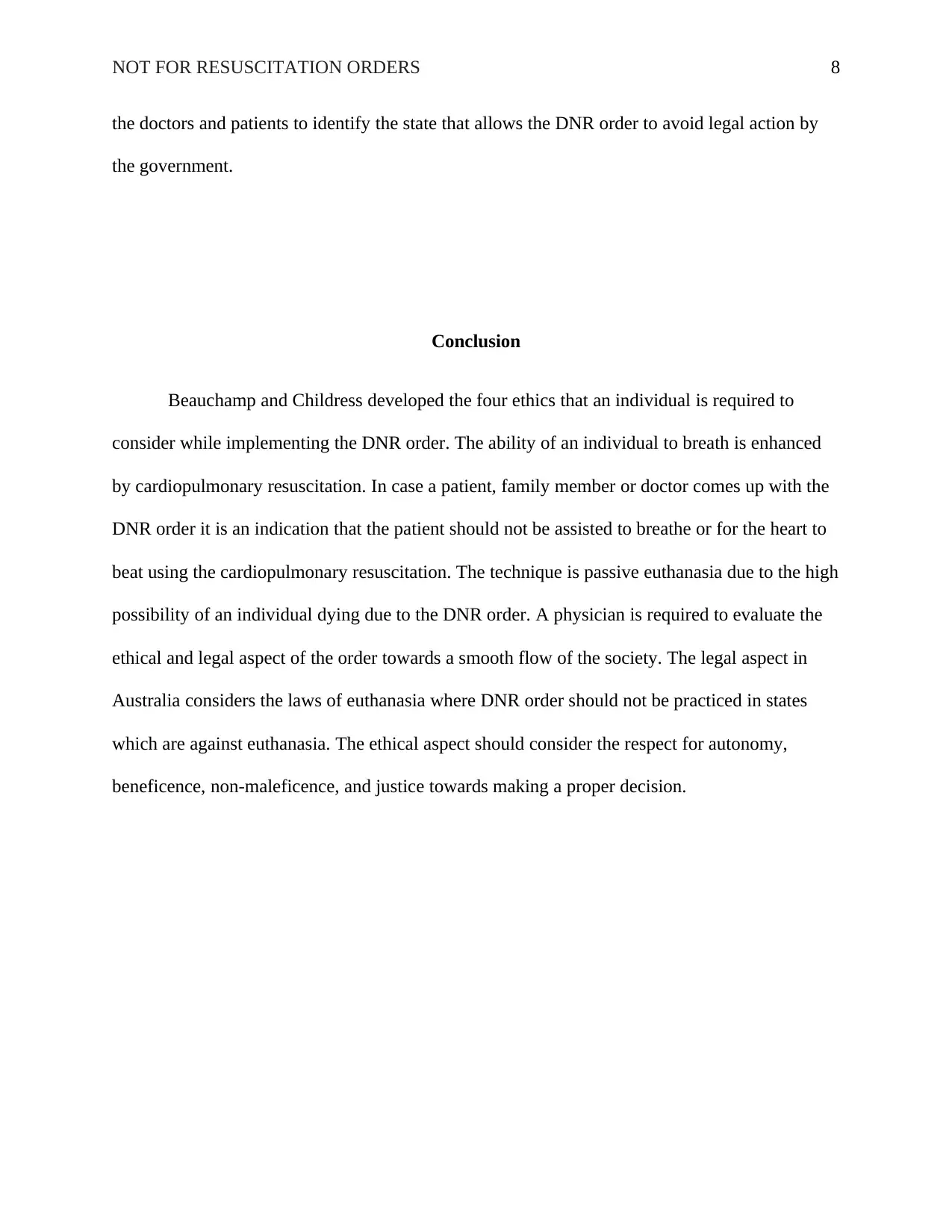
NOT FOR RESUSCITATION ORDERS 8
the doctors and patients to identify the state that allows the DNR order to avoid legal action by
the government.
Conclusion
Beauchamp and Childress developed the four ethics that an individual is required to
consider while implementing the DNR order. The ability of an individual to breath is enhanced
by cardiopulmonary resuscitation. In case a patient, family member or doctor comes up with the
DNR order it is an indication that the patient should not be assisted to breathe or for the heart to
beat using the cardiopulmonary resuscitation. The technique is passive euthanasia due to the high
possibility of an individual dying due to the DNR order. A physician is required to evaluate the
ethical and legal aspect of the order towards a smooth flow of the society. The legal aspect in
Australia considers the laws of euthanasia where DNR order should not be practiced in states
which are against euthanasia. The ethical aspect should consider the respect for autonomy,
beneficence, non-maleficence, and justice towards making a proper decision.
the doctors and patients to identify the state that allows the DNR order to avoid legal action by
the government.
Conclusion
Beauchamp and Childress developed the four ethics that an individual is required to
consider while implementing the DNR order. The ability of an individual to breath is enhanced
by cardiopulmonary resuscitation. In case a patient, family member or doctor comes up with the
DNR order it is an indication that the patient should not be assisted to breathe or for the heart to
beat using the cardiopulmonary resuscitation. The technique is passive euthanasia due to the high
possibility of an individual dying due to the DNR order. A physician is required to evaluate the
ethical and legal aspect of the order towards a smooth flow of the society. The legal aspect in
Australia considers the laws of euthanasia where DNR order should not be practiced in states
which are against euthanasia. The ethical aspect should consider the respect for autonomy,
beneficence, non-maleficence, and justice towards making a proper decision.
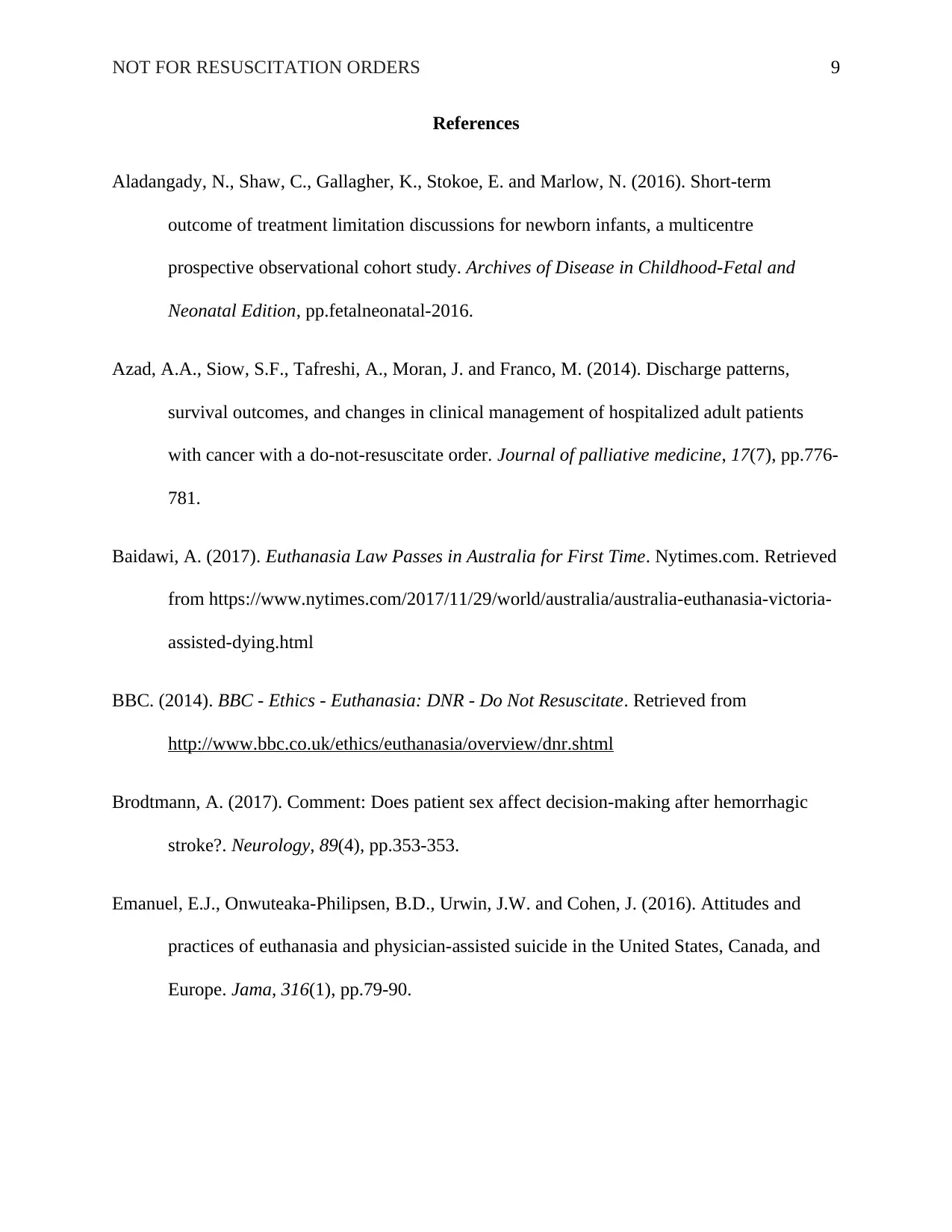
NOT FOR RESUSCITATION ORDERS 9
References
Aladangady, N., Shaw, C., Gallagher, K., Stokoe, E. and Marlow, N. (2016). Short-term
outcome of treatment limitation discussions for newborn infants, a multicentre
prospective observational cohort study. Archives of Disease in Childhood-Fetal and
Neonatal Edition, pp.fetalneonatal-2016.
Azad, A.A., Siow, S.F., Tafreshi, A., Moran, J. and Franco, M. (2014). Discharge patterns,
survival outcomes, and changes in clinical management of hospitalized adult patients
with cancer with a do-not-resuscitate order. Journal of palliative medicine, 17(7), pp.776-
781.
Baidawi, A. (2017). Euthanasia Law Passes in Australia for First Time. Nytimes.com. Retrieved
from https://www.nytimes.com/2017/11/29/world/australia/australia-euthanasia-victoria-
assisted-dying.html
BBC. (2014). BBC - Ethics - Euthanasia: DNR - Do Not Resuscitate. Retrieved from
http://www.bbc.co.uk/ethics/euthanasia/overview/dnr.shtml
Brodtmann, A. (2017). Comment: Does patient sex affect decision-making after hemorrhagic
stroke?. Neurology, 89(4), pp.353-353.
Emanuel, E.J., Onwuteaka-Philipsen, B.D., Urwin, J.W. and Cohen, J. (2016). Attitudes and
practices of euthanasia and physician-assisted suicide in the United States, Canada, and
Europe. Jama, 316(1), pp.79-90.
References
Aladangady, N., Shaw, C., Gallagher, K., Stokoe, E. and Marlow, N. (2016). Short-term
outcome of treatment limitation discussions for newborn infants, a multicentre
prospective observational cohort study. Archives of Disease in Childhood-Fetal and
Neonatal Edition, pp.fetalneonatal-2016.
Azad, A.A., Siow, S.F., Tafreshi, A., Moran, J. and Franco, M. (2014). Discharge patterns,
survival outcomes, and changes in clinical management of hospitalized adult patients
with cancer with a do-not-resuscitate order. Journal of palliative medicine, 17(7), pp.776-
781.
Baidawi, A. (2017). Euthanasia Law Passes in Australia for First Time. Nytimes.com. Retrieved
from https://www.nytimes.com/2017/11/29/world/australia/australia-euthanasia-victoria-
assisted-dying.html
BBC. (2014). BBC - Ethics - Euthanasia: DNR - Do Not Resuscitate. Retrieved from
http://www.bbc.co.uk/ethics/euthanasia/overview/dnr.shtml
Brodtmann, A. (2017). Comment: Does patient sex affect decision-making after hemorrhagic
stroke?. Neurology, 89(4), pp.353-353.
Emanuel, E.J., Onwuteaka-Philipsen, B.D., Urwin, J.W. and Cohen, J. (2016). Attitudes and
practices of euthanasia and physician-assisted suicide in the United States, Canada, and
Europe. Jama, 316(1), pp.79-90.
⊘ This is a preview!⊘
Do you want full access?
Subscribe today to unlock all pages.

Trusted by 1+ million students worldwide
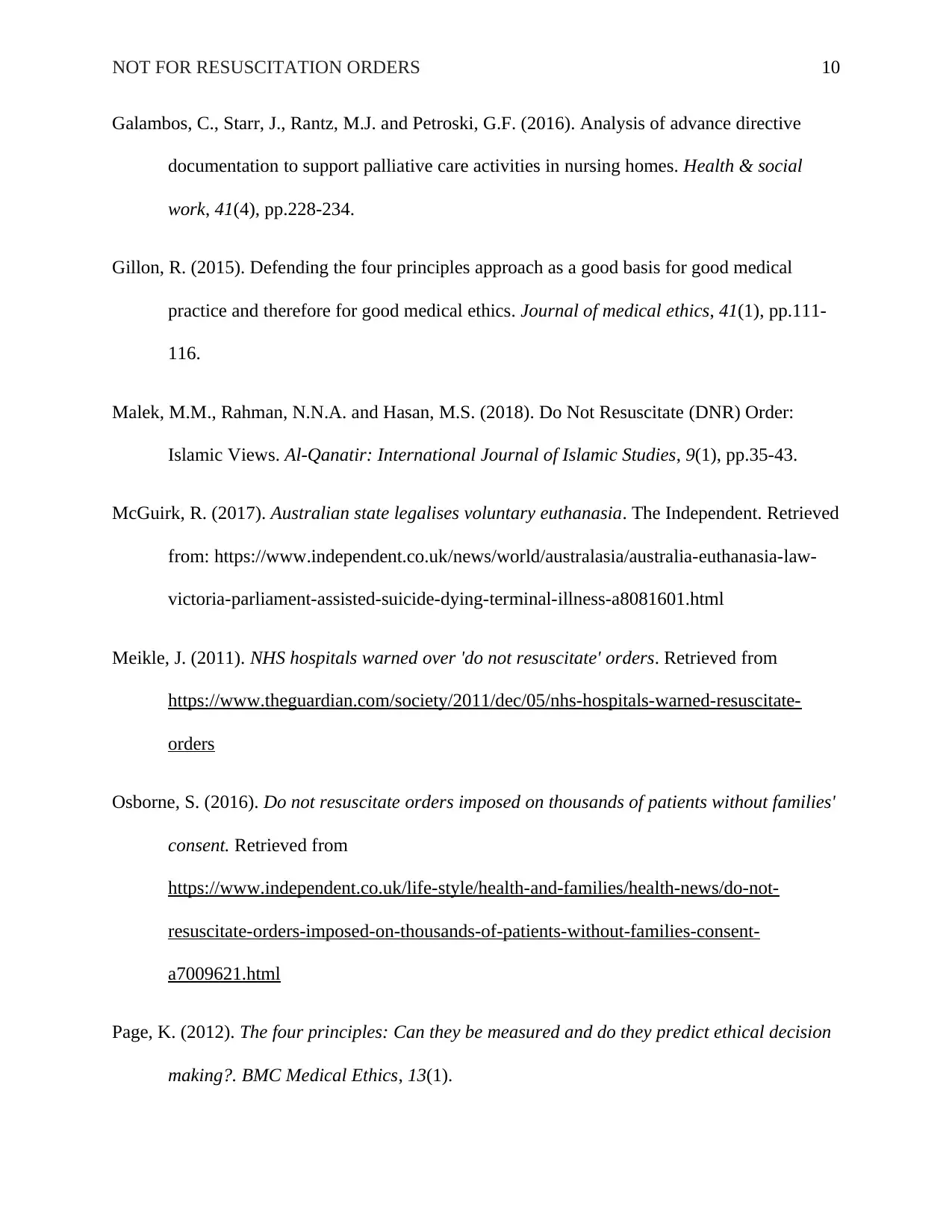
NOT FOR RESUSCITATION ORDERS 10
Galambos, C., Starr, J., Rantz, M.J. and Petroski, G.F. (2016). Analysis of advance directive
documentation to support palliative care activities in nursing homes. Health & social
work, 41(4), pp.228-234.
Gillon, R. (2015). Defending the four principles approach as a good basis for good medical
practice and therefore for good medical ethics. Journal of medical ethics, 41(1), pp.111-
116.
Malek, M.M., Rahman, N.N.A. and Hasan, M.S. (2018). Do Not Resuscitate (DNR) Order:
Islamic Views. Al-Qanatir: International Journal of Islamic Studies, 9(1), pp.35-43.
McGuirk, R. (2017). Australian state legalises voluntary euthanasia. The Independent. Retrieved
from: https://www.independent.co.uk/news/world/australasia/australia-euthanasia-law-
victoria-parliament-assisted-suicide-dying-terminal-illness-a8081601.html
Meikle, J. (2011). NHS hospitals warned over 'do not resuscitate' orders. Retrieved from
https://www.theguardian.com/society/2011/dec/05/nhs-hospitals-warned-resuscitate-
orders
Osborne, S. (2016). Do not resuscitate orders imposed on thousands of patients without families'
consent. Retrieved from
https://www.independent.co.uk/life-style/health-and-families/health-news/do-not-
resuscitate-orders-imposed-on-thousands-of-patients-without-families-consent-
a7009621.html
Page, K. (2012). The four principles: Can they be measured and do they predict ethical decision
making?. BMC Medical Ethics, 13(1).
Galambos, C., Starr, J., Rantz, M.J. and Petroski, G.F. (2016). Analysis of advance directive
documentation to support palliative care activities in nursing homes. Health & social
work, 41(4), pp.228-234.
Gillon, R. (2015). Defending the four principles approach as a good basis for good medical
practice and therefore for good medical ethics. Journal of medical ethics, 41(1), pp.111-
116.
Malek, M.M., Rahman, N.N.A. and Hasan, M.S. (2018). Do Not Resuscitate (DNR) Order:
Islamic Views. Al-Qanatir: International Journal of Islamic Studies, 9(1), pp.35-43.
McGuirk, R. (2017). Australian state legalises voluntary euthanasia. The Independent. Retrieved
from: https://www.independent.co.uk/news/world/australasia/australia-euthanasia-law-
victoria-parliament-assisted-suicide-dying-terminal-illness-a8081601.html
Meikle, J. (2011). NHS hospitals warned over 'do not resuscitate' orders. Retrieved from
https://www.theguardian.com/society/2011/dec/05/nhs-hospitals-warned-resuscitate-
orders
Osborne, S. (2016). Do not resuscitate orders imposed on thousands of patients without families'
consent. Retrieved from
https://www.independent.co.uk/life-style/health-and-families/health-news/do-not-
resuscitate-orders-imposed-on-thousands-of-patients-without-families-consent-
a7009621.html
Page, K. (2012). The four principles: Can they be measured and do they predict ethical decision
making?. BMC Medical Ethics, 13(1).
Paraphrase This Document
Need a fresh take? Get an instant paraphrase of this document with our AI Paraphraser
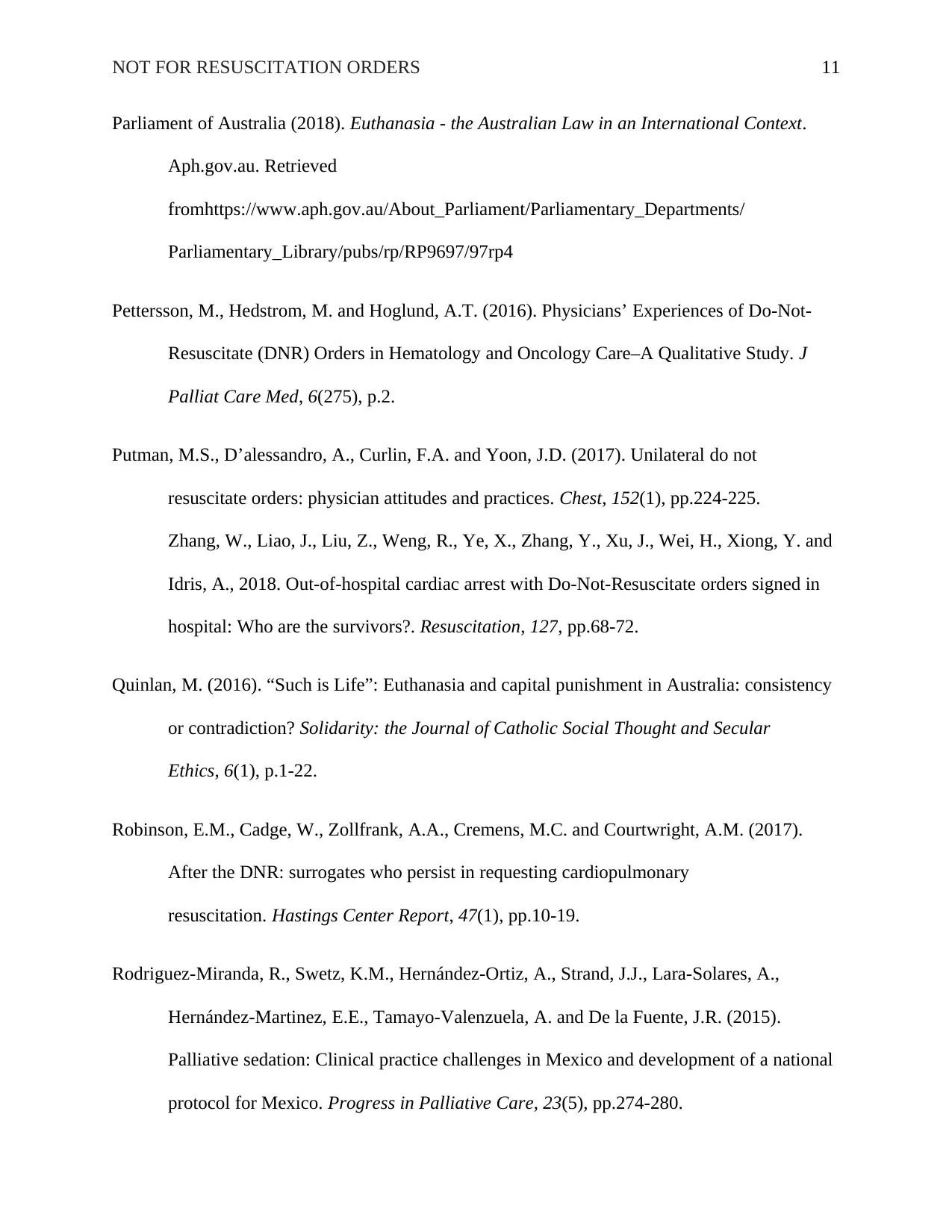
NOT FOR RESUSCITATION ORDERS 11
Parliament of Australia (2018). Euthanasia - the Australian Law in an International Context.
Aph.gov.au. Retrieved
fromhttps://www.aph.gov.au/About_Parliament/Parliamentary_Departments/
Parliamentary_Library/pubs/rp/RP9697/97rp4
Pettersson, M., Hedstrom, M. and Hoglund, A.T. (2016). Physicians’ Experiences of Do-Not-
Resuscitate (DNR) Orders in Hematology and Oncology Care–A Qualitative Study. J
Palliat Care Med, 6(275), p.2.
Putman, M.S., D’alessandro, A., Curlin, F.A. and Yoon, J.D. (2017). Unilateral do not
resuscitate orders: physician attitudes and practices. Chest, 152(1), pp.224-225.
Zhang, W., Liao, J., Liu, Z., Weng, R., Ye, X., Zhang, Y., Xu, J., Wei, H., Xiong, Y. and
Idris, A., 2018. Out-of-hospital cardiac arrest with Do-Not-Resuscitate orders signed in
hospital: Who are the survivors?. Resuscitation, 127, pp.68-72.
Quinlan, M. (2016). “Such is Life”: Euthanasia and capital punishment in Australia: consistency
or contradiction? Solidarity: the Journal of Catholic Social Thought and Secular
Ethics, 6(1), p.1-22.
Robinson, E.M., Cadge, W., Zollfrank, A.A., Cremens, M.C. and Courtwright, A.M. (2017).
After the DNR: surrogates who persist in requesting cardiopulmonary
resuscitation. Hastings Center Report, 47(1), pp.10-19.
Rodriguez-Miranda, R., Swetz, K.M., Hernández-Ortiz, A., Strand, J.J., Lara-Solares, A.,
Hernández-Martinez, E.E., Tamayo-Valenzuela, A. and De la Fuente, J.R. (2015).
Palliative sedation: Clinical practice challenges in Mexico and development of a national
protocol for Mexico. Progress in Palliative Care, 23(5), pp.274-280.
Parliament of Australia (2018). Euthanasia - the Australian Law in an International Context.
Aph.gov.au. Retrieved
fromhttps://www.aph.gov.au/About_Parliament/Parliamentary_Departments/
Parliamentary_Library/pubs/rp/RP9697/97rp4
Pettersson, M., Hedstrom, M. and Hoglund, A.T. (2016). Physicians’ Experiences of Do-Not-
Resuscitate (DNR) Orders in Hematology and Oncology Care–A Qualitative Study. J
Palliat Care Med, 6(275), p.2.
Putman, M.S., D’alessandro, A., Curlin, F.A. and Yoon, J.D. (2017). Unilateral do not
resuscitate orders: physician attitudes and practices. Chest, 152(1), pp.224-225.
Zhang, W., Liao, J., Liu, Z., Weng, R., Ye, X., Zhang, Y., Xu, J., Wei, H., Xiong, Y. and
Idris, A., 2018. Out-of-hospital cardiac arrest with Do-Not-Resuscitate orders signed in
hospital: Who are the survivors?. Resuscitation, 127, pp.68-72.
Quinlan, M. (2016). “Such is Life”: Euthanasia and capital punishment in Australia: consistency
or contradiction? Solidarity: the Journal of Catholic Social Thought and Secular
Ethics, 6(1), p.1-22.
Robinson, E.M., Cadge, W., Zollfrank, A.A., Cremens, M.C. and Courtwright, A.M. (2017).
After the DNR: surrogates who persist in requesting cardiopulmonary
resuscitation. Hastings Center Report, 47(1), pp.10-19.
Rodriguez-Miranda, R., Swetz, K.M., Hernández-Ortiz, A., Strand, J.J., Lara-Solares, A.,
Hernández-Martinez, E.E., Tamayo-Valenzuela, A. and De la Fuente, J.R. (2015).
Palliative sedation: Clinical practice challenges in Mexico and development of a national
protocol for Mexico. Progress in Palliative Care, 23(5), pp.274-280.
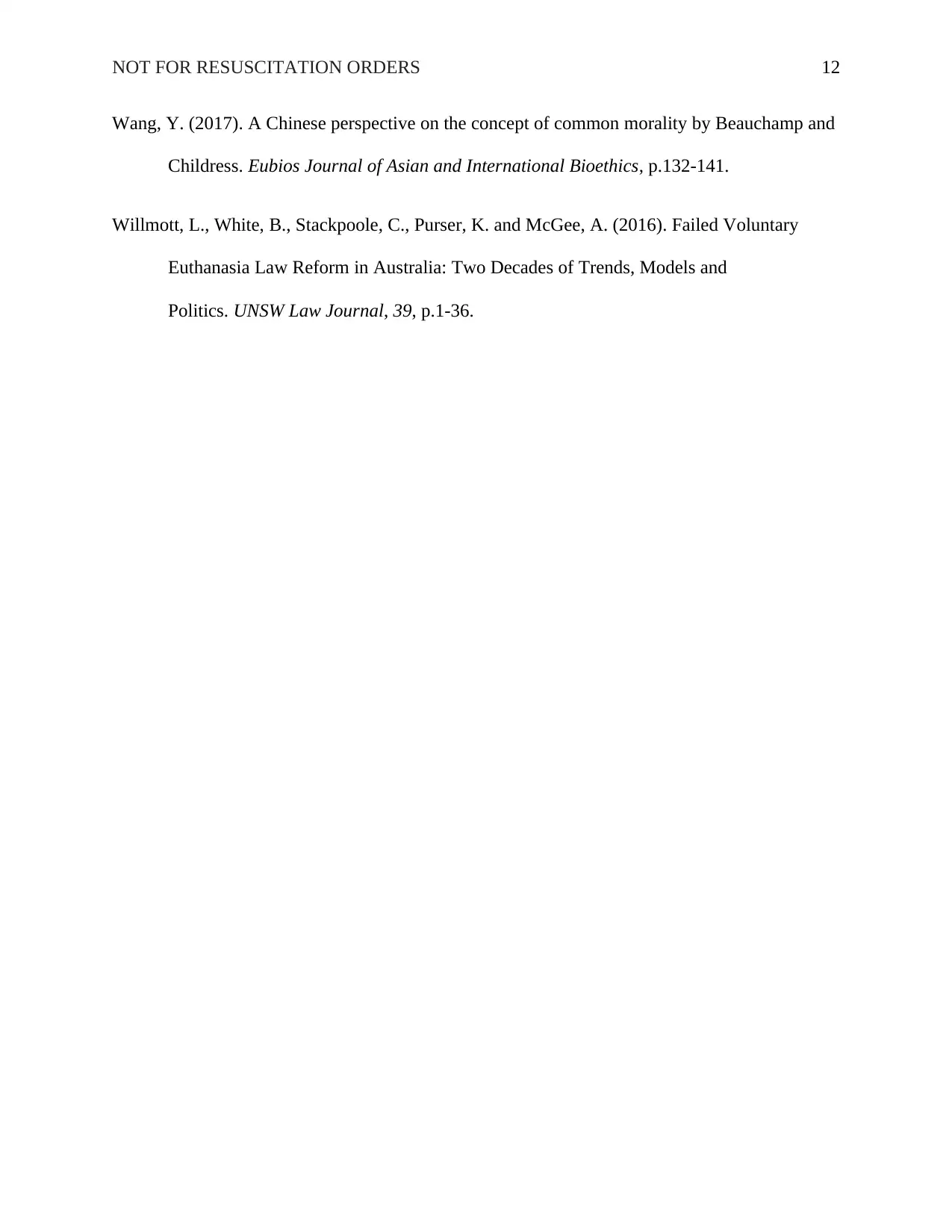
NOT FOR RESUSCITATION ORDERS 12
Wang, Y. (2017). A Chinese perspective on the concept of common morality by Beauchamp and
Childress. Eubios Journal of Asian and International Bioethics, p.132-141.
Willmott, L., White, B., Stackpoole, C., Purser, K. and McGee, A. (2016). Failed Voluntary
Euthanasia Law Reform in Australia: Two Decades of Trends, Models and
Politics. UNSW Law Journal, 39, p.1-36.
Wang, Y. (2017). A Chinese perspective on the concept of common morality by Beauchamp and
Childress. Eubios Journal of Asian and International Bioethics, p.132-141.
Willmott, L., White, B., Stackpoole, C., Purser, K. and McGee, A. (2016). Failed Voluntary
Euthanasia Law Reform in Australia: Two Decades of Trends, Models and
Politics. UNSW Law Journal, 39, p.1-36.
⊘ This is a preview!⊘
Do you want full access?
Subscribe today to unlock all pages.

Trusted by 1+ million students worldwide
1 out of 12
Related Documents
Your All-in-One AI-Powered Toolkit for Academic Success.
+13062052269
info@desklib.com
Available 24*7 on WhatsApp / Email
![[object Object]](/_next/static/media/star-bottom.7253800d.svg)
Unlock your academic potential
Copyright © 2020–2025 A2Z Services. All Rights Reserved. Developed and managed by ZUCOL.





